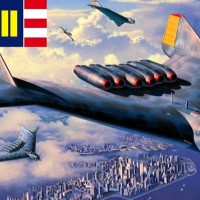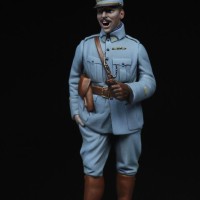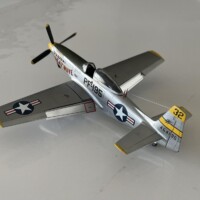The other P.24
Background
After finishing my P.24A I was left with almost a complete Bulgarian P.24B kit (minus the engine faceplate) and the engine faceplate from the P.24A kit. As I mentioned before - this faceplate was pierced and only used on KTF built P.24s. My P.24A was a PZL built example. The Bulgarian P.24B is basically the same as the P.24C used by the Turkish Air Force so a KTF built P.24C was a good solution. The only issue would be sourcing the necessary decals but more on that below.
History
The Turkish P.24 order included two batches of license built aircraft - as well as PZL built examples - to be built at the government aircraft company KTF (Kayseri Tayyare Fabrikasi) which opened in 1932 to license build aircraft for the Turkish Air Force. Prior to the P.24 order they had manufactured Curtiss Hawk IIs and Curtiss Fledgling 2 C1s and were in the middle of building a series of Gotha 145s under German supervision. The Turkish government was keen to acquire aeronautical engineering knowledge and so was very interested in license production. The issue for KTF was that the P.24 was a very modern aircraft and their engineering skills weren't quite up to that standard yet. A request was made for a Polish team to supervise the early construction and the head of PZL's Fuselage and Wing Construction section - Wilhelm Gibałka was appointed and arrived in October 1936. He was allocated a team of five engineers who joined him later. Gibałka requested that he be allowed to take his wife, Eugina, and daughter, Wanda, with him which wasn't well received by PZL upper management. The Turkish side was, however, delighted by the idea and agreed to pay for their transport and stay. Gibałka was later to describe this as an inspired move as the presence of his wife and daughter indicated his significance and high status and indicated that PZL took the order very seriously. The rest of his team were also permitted to bring their families.
Gibałka and his team got on well with the KTF management and employees. Initially, there was trouble with the Germans supervising the Gotha 145 construction who spread anti-Polish rumours but Gibałka was able to turn this around and in the end the Polish engineers were helping the Germans construct their aircraft as well. The Polish embassy was also unfriendly but kept away from Kayseri and didn't interfere. Gibałka and his team had to struggle with damaged or shoddily constructed PZL parts delivered to KTF but through hard work overcame these. His patience and ability were highly valued and KTF was sad to see him go when he returned to Poland in September 1937. So much so that a Polish team was requested to organize THK Etimesgut factory in Ankara when a license agreement was signed to produce Miles M14A and the Turks specifically requested that Gibałka be included. News of this reached KTF in Kayseri and Gibałka was invited to visit for a very pleasant and rewarding reunion. The P.24As and Cs served Turkey well and the KTF built examples were popular and useful aircraft though having little effective use as they were obsolete by the beginning of World War II.
The Model
As mentioned above I acquired the IBG 1/72 P.24B kit for it's engine faceplate which is needed for all PZL built Turkish P.24As and Cs (though #2126 was later fitted with a KTF faceplate). The parts in the P.24B kit enable one to build a PZL P.24C very easily though one has to source decals from elsewhere. Why IBG couldn't include the correct engine faceplate in the P.24A boxing escapes me as it's on a separate small sprue and they specifically include decals for a PZL P.24A. They are very generous with their parts (including whole sprues when one just needs one part) and one can only assume it's a brainfart. The P.24B kit is up to their usual high quality standards and the decal sheet in particular is a work of art. If you want to build a Bulgarian P.24 this is the way to go. It also contains the necessary parts for a P.24G and P.24C - one just has to source the decals.
Decals
Turkish decals are thin on the ground though and finding sheets for the P.24s is difficult. I chose to model #2127, the first KTF built P.24C and despite having left over stencils and KTF logos from the P.24A boxing needed to find serial numbers and Turkish national logos. For this project I decided to go for custom decals and contacted Tarik of Babibi Models (who specializes in Turkish subjects) to see if he could help. Tarik was extremely helpful and responsive and produced a superb set of decals which worked wonderfully well. If one does go down the custom road one does need to follow certain rules. Firstly, one has to provide detailed information, measurements and, if possible photos. The more precise the measurements the better. Colours need to be specified and one needs to be patient. These guys have other careers and their response time can naturally be slow (by slow I mean weeks and even months). They are willing to help though and whatever one can do to make their task easier helps a lot. Here a caution - avoid Bedlam Creations. The work is very good but the experience of dealing with the proprietor is not worth the effort. Arctic Decals, LM Decals and Babibi Decals are all reliable and very reasonable suppliers who operate to a high standard.
Building the model
Everything that I said in my P.24A article applies to the P.24C. The kit goes together well and easily. It is a fun build. As before I scratch built the pitot tube, Holt flare holders and the tail skid. The engine bearer rods were replaced with 0.2 mm brass wire and the Venturi tube was an IBG aftermarket example. Gun barrels were Master which really enhance the kit. The canopy is typical Turkish style using the etched brass parts provided. For the colour scheme I departed from my usual pratice and started with a base coat of Mr Color Super Duralumin (SM208). Then I applied a coat of Tamiya X-11 chrome silver enamel which produced a very impressive finish. The propeller boss was chrome painted with a Molotov pen. The decals are a mixture of left over IBG stencils and Babibi custom decals both of which performed perfectly.
Conclusion
I'm very pleased with this model. I now have a Turkish KTF built P.24C and only need the Greek P.24F to complete my Aegean P.24 series. Like all the IBG P.24 kits this is a nice model and the best on the market.









Another superb result, Christopher!
Perfectly researched, wonderfully done!
Congratulations!
Hi Spiros
Many, many thanks - this turned out to be a very enjoyable project.
Definitely a wonderful result, Christopher @christopher
I was not even aware that this aircraft was used in Turkey, thanks for sharing all this information.
Thanks ever so much John (@johnb). Turkish interwar aviation is actually really fascinating.
@christopher - excellent result!
Thanks very much Tom - much appreciated.
Looks great! Well done.
Thanks ever so much Greg.
Great P.24!
Many thanks capt.R!